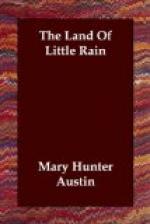In the neighborhood of towns founded by the Spanish Californians, whether this plant is native to the locality or not, one can always find aromatic clumps of yerba buena, the “good herb” (Micromeria Douglassii). The virtue of it as a febrifuge was taught to the mission fathers by the neophytes, and wise old dames of my acquaintance have worked astonishing cures with it and the succulent yerba mansa. This last is native to wet meadows and distinguished enough to have a family all to itself.
Where the irrigating ditches are shallow and a little neglected, they choke quickly with watercress that multiplies about the lowest Sierra springs. It is characteristic of the frequenters of water borders near man haunts, that they are chiefly of the sorts that are useful to man, as if they made their services an excuse for the intrusion. The joint-grass of soggy pastures produces edible, nut-flavored tubers, called by the Indians taboose. The common reed of the ultramontane marshes (here Phragmites vulgaris), a very stately, whispering reed, light and strong for shafts or arrows, affords sweet sap and pith which makes a passable sugar.
It seems the secrets of plant powers and influences yield themselves most readily to primitive peoples, at least one never hears of the knowledge coming from any other source. The Indian never concerns himself, as the botanist and the poet, with the plant’s appearances and relations, but with what it can do for him. It can do much, but how do you suppose he finds it out; what instincts or accidents guide him? How does a cat know when to eat catnip? Why do western bred cattle avoid loco weed, and strangers eat it and go mad? One might suppose that in a time of famine the Paiutes digged wild parsnip in meadow corners and died from eating it, and so learned to produce death swiftly and at will. But how did they learn, repenting in the last agony, that animal fat is the best antidote for its virulence; and who taught them that the essence of joint pine (Ephedra nevadensis), which looks to have no juice in it of any sort, is efficacious in stomachic disorders. But they so understand and so use. One believes it to be a sort of instinct atrophied by disuse in a complexer civilization. I remember very well when I came first upon a wet meadow of yerba mansa, not knowing its name or use. It looked potent; the cool, shiny leaves, the succulent, pink stems and fruity bloom. A little touch, a hint, a word, and I should have known what use to put them to. So I felt, unwilling to leave it until we had come to an understanding. So a musician might have felt in the presence of an instrument known to be within his province, but beyond his power. It was with the relieved sense of having shaped a long surmise that I watched the Senora Romero make a poultice of it for my burned hand.




